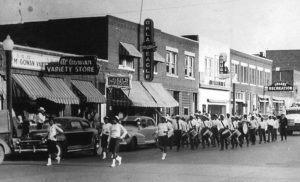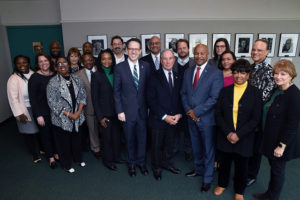Tulsa has been named a Bloomberg Philanthropies 2018 Public Art Challenge winner. The city will receive $1 million for The Greenwood Art Project, a group of temporary public artworks to celebrate and commemorate a vibrant community known as Black Wall Street.
The University of Tulsa is honored to partner with the 1921 Tulsa Race Massacre Centennial Commission. “This is a momentous day for Tulsa,” said TU President Gerard Clancy. “The meaningful work going on both publicly and behind the scenes will culminate in a brighter future for our city and our state, and TU is grateful to be a part of this transformative project.”
TU Associate Professor of Film Studies and Arts and Cultural Committee Chair for the 2021 Centennial Commission Steering Committee Jeff Van Hanken is working alongside internationally renowned artist and MacArthur Fellow Rick Lowe to collaborate with local artists to tell the story of this neighborhood through a series of eight art installations. “The idea was to think about art as it connects to economic development, cultural development and social cohesion,” Van Hanken said.

The Greenwood district is a place of unity and resilience, but shadows of the past linger. Black Wall Street was the most prominent district of black-owned businesses in America in the early 20th century. In 1921, this community was devastated by racially motivated attacks known as the Tulsa Race Massacre. The Greenwood Art Project seeks to celebrate the history of Black Wall Street and create a more equitable future for residents and visitors.
“The story of Black Wall Street is already one of triumph and tragedy,” Lowe said. “Through the Greenwood Art Project in time for the 100th anniversary of the Tulsa Race Massacre, we have the opportunity to establish a future of prosperity, reconciliation and unity – a narrative that every city in America stands to learn from.”
This isn’t a bandage on a deep historical scar but a continuation of a significant conversation that the Greenwood neighborhood has been discussing for years. “It’s important to think of it as a long process,” Van Hanken explained. “These efforts don’t end in 2021. This should move the city and the community of Greenwood toward better representation politically, economically, culturally and socially.”

At the Greenwood Art Project announcement, former New York City Mayor and philanthropist Michael Bloomberg shared his experience touring Tulsa sites. “Public art has the unique ability to reach people and change the way that we think about the world around us,” Bloomberg said. “I saw that today first hand at the Gathering Place here in Tulsa. That’s a piece of public art if there ever was one.”
Art is a catalyst for difficult but necessary conversations. Tulsa Mayor G.T. Bynum is ready to enter the dialogue. “We are at a time in America where hate is becoming normalized. Where it’s becoming comfortable for people to assume the worst about other people because of a disagreement or because they are different,” Bynum said. “But this place is also a reminder of the resilience of good people and their ability to pull together in the face of remarkable tragedy and transcend the hatred that they have been afflicted by and build a better future for another generation.”

The Greenwood Art Project fits neatly with ongoing research at The University of Tulsa. “We have a project called the Center for Health Art and Measurement Practices. This is an effort to study the way that art can make an impact on health,” Van Hanken said. “These kinds of social and community impact projects that invite art into the conversation are growing nationally. TU is in a position to build on it and contribute to it as a university and as faculty and students.”






